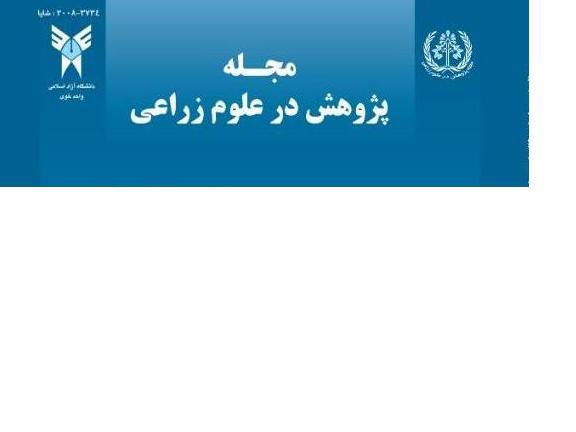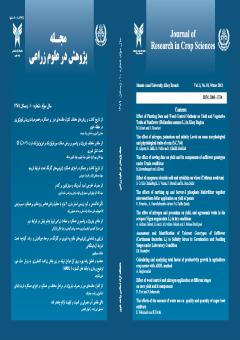اثر مقادير مختلف نيتروژن و پتاسيم بر برخي صفات مورفولوژيك و فيزيولوژيك ذرت (704.C. S) تحت تنش شوري
محورهای موضوعی : توليد محصولات زراعي
کلید واژه: ذرت, نيتروژن, پتاسيم, شوري ,
چکیده مقاله :
به منظور بررسي اثرات شوري بر برخي صفات مورفولوژيك و فيزيولوژيك ذرت آزمايشي به صورت فاكتوريل در قالب طرح كامل تصادفي در 4 تكرار بر رقم 704 ذرت در شرايط گلخانهاي در سال 1388 اجرا گرديد. عامل A در دو سطح شامل: (1a: آب آبياري به عنوان شاهد 2а: شوري dS/m6) ، عامل B در سه سطح شامل (1b: ميزان نيتروژن بر اساس آزمون خاك، 2b: ميزان نيتروژن 50 درصد بيشتر از آزمون خاك، 3b: ميزان نيتروژن 100 درصد بيشتر از آزمون خاك) و عامل C در سه سطح شامل: (1C: ميزان پتاسيم بر اساس آزمون خاك، 2C: ميزان پتاسيم 50 درصد بيشتر از آزمون خاك و 3C: ميزان پتاسيم 100 درصد بيشتر از آزمون خاك) بود. در طي دوره رشد، صفات مورفولوژيكي از قبيل قطر ساقه و ارتفاع بوته در دو مرحله زماني، تعداد برگ در زمان برداشت، ميزان سبزينگي در دو مرحله زماني، سطح برگ، محتوي آب نسبي و شاخص پايداري غشا مورد مطالعه قرار گرفت. نتايج نشان داد اعمال شوري باعث كاهش قطر ساقه، ارتفاع بوته، سطح برگ، محتوي آب نسبي شد. در حاليكه درصد سبزينگي و شاخص پايداري غشا افزايش يافت ولي تاثير معنيداري بر روي تعداد برگ نداشت. با افزايش مصرف نيتروژن در شرايط شور ارتفاع بوته، ميزان سبزينگي، سطح برگ، محتوي آب نسبي و شاخص پايداري غشا افزايش يافت. به طوريكه بيشترين سطح برگ معادل 178/0 مترمربع در بوته با مصرف 50 درصد نیتروژن بيشتر از آزمون خاک حاصل شد، مصرف پتاسيم در شرايط شور و بدون شوري باعث ايجاد تغييراتي در شاخصهای رشد شد به طوريكه در شرايط شور، بيشترين ارتفاع در مصرف 100 درصد بيشتر از مقدار پتاسيم حاصل شد كه با مقدار 50 درصد بيشتر از آن تفاوت معنيداري نداشت.
To study the effects of salinity on morphological and physiological characteristics, an experiment was performed in Factorial completely randomized design with four replications in greenhouse condition in 1388. Factor A included two levels of salinity a1) The salinity of irrigation water as control a2) The salinity of 6 dS/m , factor B include three levels b1)the rate of nitrogen based on soil test, b2) the rate of nitrogen is 50% more than soil test b3) the rate of nitrogen is 100% more than soil test, and factor C also included in three, levels C1) the rate of potassium based on soil test C2) the rate of potassium is 50% more than soil test, and C3) the rate of potassium is 100% more than soil test. During the growth morphological characteristics were studied: diameter of stem height of shrub in two time stages, number of leaves in harvest time, the greenish rate in two times, leaf surface, relative water content and membrane stability indicator. The result showed that the exertion of salinity causesd the decrease of stem diameter, height of shrub, Leaf area, and relative water content. However the greenish rate and membrane stability indicator were increased but this didn’t have any meaningful effect on the number of leaves .With nitrogen usage increase at sline condition there was a meaningful increase in shrub height greenish rate, leaf surface, relative water content and membrane stability indicator. Also it was shown that with application of 50% of nitrogen the greatest leaf surface increases to 0/178m2 was attained.The use of potassium with and without salinity condition caused some changes. In salinity condition the height was increased with the usage of 100% potassium (50%) there was no significant difference.
Alebrahim,M.T., N.Sabaghnia , A.Ebad,and M.Mohebodini. 2004. Investigation the effect of salt and drought stress on seed germination of thyme medicinal plant (thymus vulgar is). J. Res. Agric. Sci.1:13_20.
Barrin,M., N AliAsgarzadeh, A.Samadi. 2006. Effect of NaCl salinity on proline concentration and some growth characteristics of tomato in symbiosis of VAM. J.Iranian Agric.Sci.(in Persian),37(1):139-147.
Benlloch, M., M. A. Ojeda, and A. Rodriguez-Navarro. 1994. Salts ensitivity and low discrimination between potassium and sodium in bean plants. Plant Soil, 166:117-123.
Chartzoulakis, K. S. and M. H. Loupassaki,. 1997.E ffects of NaCl salinity on germination, growth, gas exchange, yield of greenhouse eggplant.Water Management. 32: 215-225.
Darya, S.S.,and M.Singh. 1976. Effects of salinity, alkalinity and iron application on the availability of iron, manganese, phosphorus and sodium in pea crop .Plant and Soil.44:697-702.
Davies,K.J. 1995 .Oxidative stress: The paradox of aerobic life. Brioch Soc. Symp. 61:1-31.
Daugga, K.S.J.G. Wanes, and L. Leanard.1988. Nitrate absorbtion by corn roots, Inhibition by phenylglyoxal. Plant Physical.86:759-763.
Durey, R.S, and M. Pessarakli .1995. Physical mechanism of nitrogen absorption and assimilation in plants under stress conditions. Pp. 605-625 in: pessarakli (Ed), handbook of plants and crop physiology. Marcel Dekker Inc., New York.
Fiehn,O., J.Kopka,N.Trethewey, and L.Willmitzer. 2002 .Identification of uncommon plant metabolites based on calculation of composition using gas chromatography and quadropole mass spectrometry. Anal. Chem.72, 3573_3580.
Grarttan, S.R., and C.M Grieve.1999a. Mineral nutrient acquisition and response by plant grown in saline environments. In: Handbook of Plant and CropS tress Ed. Pessarakli, M., PP.203-229.Marcel Dekker New York.
Grattan, S .R. and C.M.Grieve. 1994b. Mineral nutrient acquisition and response by Plants grown in saline environments .In: Handbook ofP lant and Crop Stress(Ed).M.P essarakli, marcel Decker, New York.
Grammar, G. R., J. Lynch, A. Lauchli and E. Epstein. 1987. Influx Na+, K+, and Ca+ form the plasma of root cells. A primary response of salt stress. Plant physiol. 79: 207-211.
Hasani,A. 2003. Effect of salinity and drought stress from NaCl in some morphological and physiological characteristics of basil(ocimum basilicum) var.Kashkani lolo,Ph.D. thesis in Agronomy, Tarbiat modares university,Tehran
Jocic, B. and M. R. Saric.1983.Efficiency of nitrogen, phosphorus, and potassium use by corn, sunflower, and sugar beet to the synthesis of organic matter. Plant Soil. 72:219-223.
Kaya, M. D. G.Okcu, M. Atak, Y. Cikili, and O. Kolsarici.2006.seed treatments to overcome salt and drought stress during germination in sunflower (Helianthus annuls L.). Europe. J. Agron. 24:291-295.
Khalil, M. A. F. Amer and M.M. Elgabaly. 1967. A sailinity –fertitity interaction study on corn and cotton .Soil. Sci. Am. Proc .31:689-686.
Khan. M. A. and I. A. Ungar. 1985T .he role of hormones in regulators.The germination of polymorphic seeds and early seeding growth of atriplex triangular is under saline condition. Physiol. Plant., 63:109-113.
Kingbury, R.W.Epstein, E., and pearcy,. 2006. Salt Sensitivity in wheat. Plant Physiology. 80:651_654.
KholdBariin,B., T.Eslamzadeh. 2003. mineral nutrition of higher plant, Shiraz university press,797 pp.(in Persian)
Krishnamurathy, R., M. Anbazhagan, and K. B. Bhagwat.1987.Effects of sodium chloride toxicity on chlorophyll break down in rice.Indain Agric. Sci. 57: 567-570.
Lunin, J. and M.H. Gallatin.1965. Salinityf ertitity interaction in relation to growth and composition of bean. I: Effect of N, P and K. Agron. J. 57:339-342.
Mahmood,T.and W.M.Kaiser. 2003. Growth and solute composition of the salt tolerant kaller grass (heptachlor fuscal.)Vas affected by nitrogen source. Plant Soil.252:359_366.
Mohamaddoost Shidi,A. Z., A.Safarnajad, and H.Hamidi. 2009. Effect of morphological and biochemical characteristics of Ferula persica in salinity stress,J.Gen. Breed.Pasture Plant,17(1):38-49.
Majidian,M., A.Galavand, A.A.Gandomkar,N.A.Karimian.2008.Effect of drought stress,nitrogen and inorganic fertilizer ocn chlorophyll meter reading,yield and it”s components of grain corn of Single cross 704.J.Agron.Sci.10(3):23-31.(in Persian)
Neocleous, D. and M. Nasilakakis .2007 .Effects of NaCl stress on red raspberry (Rubus idoeusl Autumn Bliss). Sci. Hort. 112:282-289.
Nemati,F.,M.A. Esmaelii, S.Golizadeh. 2008.Effect of salinity stress on water relationship,osmotic adjustment,destrubition of Na and K in seedling of two genotypes of rice,J.Iranian Agron. Sci.,1(2):146-164.
Noorinia.A. 2001. Evaluetion the effect of different genotypes of wheat hexoploedes to salinity stress.Ph.D. thesis in Agronomy,IAU,research and science branch,Tehran.
Parid, A. K., and A. B. Das. 2005. Salt tolerance and salinity effects on plants a review. Ecotoxicology and Environmental Safety. 60:324-349.
Pitman, M.G.1984.Whole plants in solute transport in plant co I. A.colls tissues. (eds) Baker,D.A.,and J.L.Hall.Jahn Wiley . New York.
Salami,M.R., A.Safarnajad, and H.Hamidi. 2005. Effect of salinity stress on morphological characteristics of cemin seed(Cuminum cyminum) and basil(ocimum basilicum), J.Res. Constr.(in prersian):82:72-77.
Safarnajad,A.,M.R.Salami, and H.Hamidi. 2009a. Effect of morphological characteristics of flea wort(Plantago psyllium) in salinity stress, J.Res. Constr. 76:152-160. .(in Persian)
Safarnejad, A., A. Sadr, and H. Hamidi. 2008b.S alt effect on omrphologic characteristics of Nigell sativa, Journal of Rangelands and ForestP lant Breeding and Genetic Res .15: 75-84.
Shannon, M. C. 1986. Breading selection and the in plants of salt tolerance in: salinity tolerance in plants (eds: R. C. staples, and G. H. Toenniesn):231-252.
Singh, O. 1998. Effect of soil salinity and nitrogen on yield and nutrient uptake in okva (Hibiscus esculents). Ind. J. Agron. 43:333-337.
Soliman, M. F. 1988. Effects of salinity on growth and micronutrient composition of corn plants. Agronomy Chem., 32: 337-342.
Soliman, M. S., H. G. Shalabi, and W.F. Campbell. 1994. Interaction of salinity, nitrogen, and phosphorus fertilization on wheat K., Plant Nut. 17:1163-1173.
Stuiver,C.E.,P.J.C. Kuiper, and H.Marschenar. 2002. Lipids. Form bean, barley and sugar in relation to Res. Physiol. Plant. 42:124-128.
Turner, N. C. 1981. Techniques and experimental approaches for the measurement of plant water status. Plant Soil, 58: 339-366.
Wang, D., M. C. Shannon and C. M. Grieve. 2001. Salinity reduces radiation absorption and use efficiency in soybean .Field Crops Res. 69: 267-277.
Yang, J., J. Zhang, Z. Wag, Q. Zho and W. Wang. 2001.Remobilization of carbon reserves to water deficit during grain-filling of rice. Field Crop Res.71:97-55

